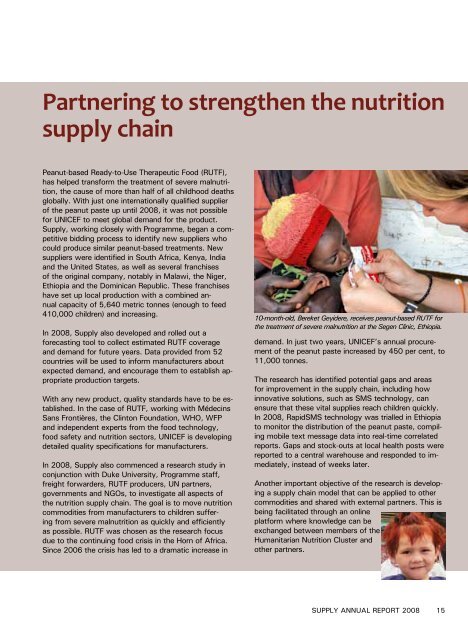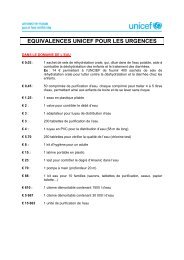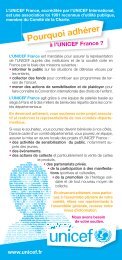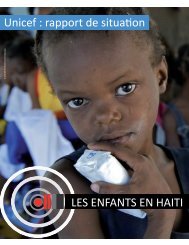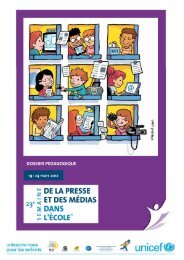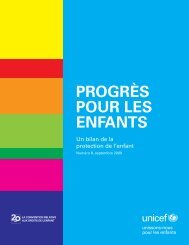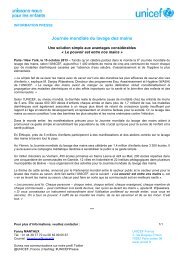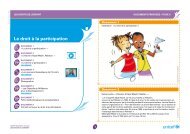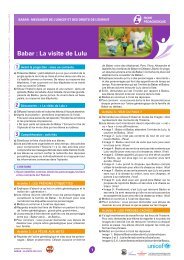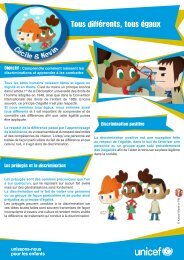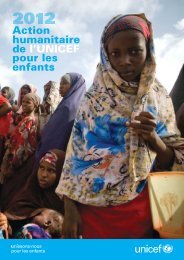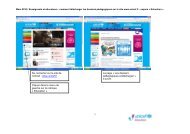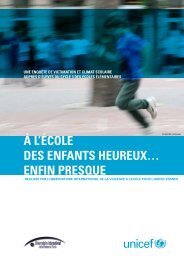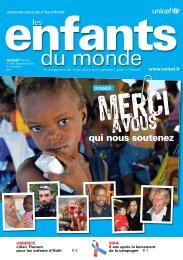SUPPLY ANNUAL REPORT 2008 Local Delivery Global ... - Unicef
SUPPLY ANNUAL REPORT 2008 Local Delivery Global ... - Unicef
SUPPLY ANNUAL REPORT 2008 Local Delivery Global ... - Unicef
Create successful ePaper yourself
Turn your PDF publications into a flip-book with our unique Google optimized e-Paper software.
Partnering to strengthen the nutrition<br />
supply chain<br />
Peanut-based Ready-to-Use Therapeutic Food (RUTF),<br />
has helped transform the treatment of severe malnutrition,<br />
the cause of more than half of all childhood deaths<br />
globally. With just one internationally qualified supplier<br />
of the peanut paste up until <strong>2008</strong>, it was not possible<br />
for UNICEF to meet global demand for the product.<br />
Supply, working closely with Programme, began a competitive<br />
bidding process to identify new suppliers who<br />
could produce similar peanut-based treatments. New<br />
suppliers were identified in South Africa, Kenya, India<br />
and the United States, as well as several franchises<br />
of the original company, notably in Malawi, the Niger,<br />
Ethiopia and the Dominican Republic. These franchises<br />
have set up local production with a combined annual<br />
capacity of 5,640 metric tonnes (enough to feed<br />
410,000 children) and increasing.<br />
In <strong>2008</strong>, Supply also developed and rolled out a<br />
forecasting tool to collect estimated RUTF coverage<br />
and demand for future years. Data provided from 52<br />
countries will be used to inform manufacturers about<br />
expected demand, and encourage them to establish appropriate<br />
production targets.<br />
With any new product, quality standards have to be established.<br />
In the case of RUTF, working with Médecins<br />
Sans Frontières, the Clinton Foundation, WHO, WFP<br />
and independent experts from the food technology,<br />
food safety and nutrition sectors, UNICEF is developing<br />
detailed quality specifications for manufacturers.<br />
In <strong>2008</strong>, Supply also commenced a research study in<br />
conjunction with Duke University, Programme staff,<br />
freight forwarders, RUTF producers, UN partners,<br />
governments and NGOs, to investigate all aspects of<br />
the nutrition supply chain. The goal is to move nutrition<br />
commodities from manufacturers to children suffering<br />
from severe malnutrition as quickly and efficiently<br />
as possible. RUTF was chosen as the research focus<br />
due to the continuing food crisis in the Horn of Africa.<br />
Since 2006 the crisis has led to a dramatic increase in<br />
10-month-old, Bereket Geyidere, receives peanut-based RUTF for<br />
the treatment of severe malnutrition at the Segen Clinic, Ethiopia.<br />
demand. In just two years, UNICEF’s annual procurement<br />
of the peanut paste increased by 450 per cent, to<br />
11,000 tonnes.<br />
The research has identified potential gaps and areas<br />
for improvement in the supply chain, including how<br />
innovative solutions, such as SMS technology, can<br />
ensure that these vital supplies reach children quickly.<br />
In <strong>2008</strong>, RapidSMS technology was trialled in Ethiopia<br />
to monitor the distribution of the peanut paste, compiling<br />
mobile text message data into real-time correlated<br />
reports. Gaps and stock-outs at local health posts were<br />
reported to a central warehouse and responded to immediately,<br />
instead of weeks later.<br />
Another important objective of the research is developing<br />
a supply chain model that can be applied to other<br />
commodities and shared with external partners. This is<br />
being facilitated through an online<br />
platform where knowledge can be<br />
exchanged between members of the<br />
Humanitarian Nutrition Cluster and<br />
other partners.<br />
<strong>SUPPLY</strong> <strong>ANNUAL</strong> <strong>REPORT</strong> <strong>2008</strong> 15


